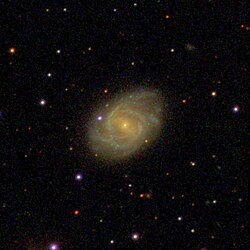NGC 1924
| Galaxie NGC 1924 | |
|---|---|
 | |
| SDSS-Aufnahme | |
| AladinLite | |
| Sternbild | Orion |
| Position Äquinoktium: J2000.0, Epoche: J2000.0 | |
| Rektaszension | 05h 28m 01,931s [1] |
| Deklination | −05° 18′ 38,73″ [1] |
| Erscheinungsbild | |
| Morphologischer Typ | SB(r)bc / HII[1] |
| Helligkeit (visuell) | 12,5 mag[2] |
| Helligkeit (B-Band) | 13,3 mag[2] |
| Winkelausdehnung | 1,6′ × 1,2′[2] |
| Positionswinkel | 140°[2] |
| Flächenhelligkeit | 13,1 mag/arcmin²[2] |
| Physikalische Daten | |
| Rotverschiebung | 0.008476 ± 0.000009[1] |
| Radialgeschwindigkeit | (2541 ± 3) km/s[1] |
| Hubbledistanz H0 = 73 km/(s • Mpc) | (109 ± 8) · 106 Lj (33,3 ± 2,3) Mpc [1] |
| Durchmesser | 50.000 Lj[3] |
| Geschichte | |
| Entdeckung | Wilhelm Herschel |
| Entdeckungsdatum | 5. Oktober 1785 |
| Katalogbezeichnungen | |
| NGC 1924 • PGC 17319 • MCG -01-14-011 • IRAS 05255-0521 • 2MASX J05280197-0518383 • GC 1130 • H III 447 • NVSS J052801-051844 • WISEA J052801.98-051838.2 | |
NGC 1924 ist eine Balken-Spiralgalaxie vom Hubble-Typ SBbc mit ausgedehnten Sternentstehungsgebieten im Sternbild Orion am Südsternhimmel. Sie ist schätzungsweise 109 Millionen Lichtjahre von der Milchstraße entfernt und hat einen Durchmesser von etwa 55.000 Lichtjahren.
Das Objekt wurde von dem Astronomen Wilhelm Herschel am 5. Oktober 1785 entdeckt.[4]
Weblinks
Einzelnachweise
Auf dieser Seite verwendete Medien
Autor/Urheber: Sloan Digital Sky Survey, Lizenz: CC BY 4.0

Angle of view: 4' × 4' (0.3" per pixel), north is up.
Details on the image processing pipeline: https://www.sdss.org/dr14/imaging/jpg-images-on-skyserver/